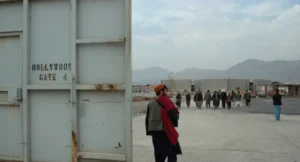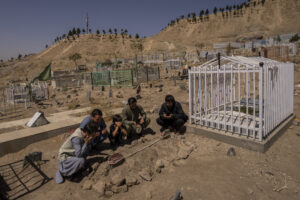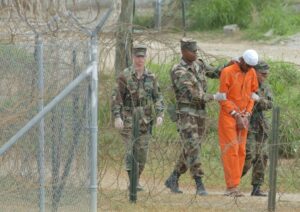More Warfare, Bombing, Deaths in Trump’s First Year
The American public’s lack of attention to the president’s violent and dangerous foreign policy helps explain our ongoing wars. Four-year-old Hawra Alaa Hassan was badly burned in a U.S. airstrike in Mosul, Iraq, in 2017. (Felipe Dana / AP)
Four-year-old Hawra Alaa Hassan was badly burned in a U.S. airstrike in Mosul, Iraq, in 2017. (Felipe Dana / AP)
The greatest impact of Donald Trump’s first year as president has been kept out of sight from most Americans. The wars the U.S. waged during Barack Obama’s tenure have sharply escalated under Trump. The result has been a predictable and massive spike in civilian deaths.
Boasting in an interview last year about an apparent retreat by Islamic State, Trump declared, “I totally changed rules of engagement. I totally changed our military.” He also touted the “big, big difference if you look at the military now” compared with what it was under the Obama administration. While Obama shares blame for escalating the use of drones, especially in Pakistan, Afghanistan and Somalia, Trump’s military leadership appears to be a return to a more traditional form of war and a complete unfettering of attempts to minimize civilian casualties.
This unfettering is evident in an almost 50 percent increase of airstrikes in Iraq and Syria during Trump’s first year in office, leading to a rise in civilian deaths by more than 200 percent compared with the year before. The watchdog group Airwars, which has tracked the U.S. war against Islamic State since 2014, remarked, “This unprecedented death toll coincided with the start of the Trump presidency, and suggested in part that policies aimed at protecting civilians had been scaled back under the new administration.” Another analysis by the U.K. organization Action on Armed Violence (AOAV) found that civilian deaths from explosive weapons in Iraq, Syria and Yemen increased by 42 percent in 2017. The group explained that the bigger death toll was largely due to “a massive increase in deadly airstrikes.” While AOAV did not single out the United States, in light of the U.S.’ overt escalation of the wars in those countries, a large proportion of the civilian deaths were likely a result of the new military strategy under Trump.
In addition to Syria and Iraq, U.S. military action in Afghanistan also has dramatically increased. As the Los Angeles Times reported in December: “Operating under looser restrictions on air power that commanders hope will break a stalemate in the war, U.S. fighter planes this year dropped 3,554 explosives in Afghanistan through Oct. 31, the most since 2012.” In December, when the U.S. was expected to slow down for the winter, as it had in the past, it instead continued a steady pace of airstrikes aimed at the Taliban. According to The Washington Post, “For the first time in 16 years, the cold has not slowed the war in the air. U.S. and Afghan forces conducted 455 airstrikes in December, an average of 15 a day, compared with just 65 the year before.”
Unsurprisingly, more civilians were killed last year in Afghanistan, compared with the last year of Obama’s tenure. The United Nations estimates that Afghan civilian deaths from airstrikes were more than 50 percent higher in the first nine months of 2017, compared with the same period a year earlier. The Trump administration also has approved the increase of U.S. troops in Afghanistan, with the grand total expected to be close to 15,000. The longest war the U.S. has ever waged appears to have no end in sight.
Somalia, another U.S. target, also has seen a sharp rise in violence and casualties under Trump. An analysis by The Guardian found that the number of U.S.-led airstrikes in Somalia in the second half of 2017 were double the total number of airstrikes during all of 2016. At least 50 civilians were killed in 2017, among them many children, but the paper said this could be an underestimate, as many deaths go unreported. It explained the increase in airstrikes:
The sudden increase in the use of air power in Somalia by the US [comes] after the relaxation of guidelines intended to prevent civilian casualties and a decision by the Trump administration to give local military commanders greater authority in ordering attacks.
America’s dramatic military escalation also has extended to its indirect role in the bloody Yemen war. According to Vox, in March 2017 there were reports that Trump was considering ramping up U.S. support to Saudi Arabia in its war on Yemen. By November it was confirmed: The U.S. was indeed increasing logistical support of the Saudi war effort by providing increased refueling support for its bombers. With such help, the Saudis have managed to keep up their deadly toll, with reports in December of more than 70 Yemeni civilians killed over a mere two days. During the nearly 3-year-old war, about 10,000 Yemeni civilians have been killed; thousands more face death from starvation or cholera.
The pattern is clear: Trump seems to have given U.S. military generals carte blanche to unleash their maximum military power in a move reminiscent of the “shock and awe” campaign during the early days of George W. Bush’s war in Iraq. The justification for unleashing this deadly military power has been the spread of Islamic State militants in a number of Arab and Muslim countries. But in the U.K., which is a major participant in the U.S.-led coalition against Islamic State, a government official admitted what most U.S. military members won’t: that it is often difficult to distinguish between an Islamic State militant and a civilian. Clive Lewis, chair of an all-party U.K. parliamentary group on drones, recently told The Guardian, “One of the challenges that has emerged from our military efforts against [Islamic State] in Iraq and Syria is a lack of clarity regarding the legal criteria by which the [Ministry of Defence] determines an individual to be an [Islamic State] combatant.”
If it is in fact difficult to determine who is an Islamic State soldier, does the U.S. really have a legal or moral basis to kill anyone? Indeed, the post-9/11 Authorization for Use of Military Force was a discredited justification under Obama and remains a questionable source of legality under Trump.
As Islamic State’s power appears to have diminished over the past several months, Trump is cautiously declaring victory. During his signing of the National Defense Authorization Act (NDAA) of 2018, Trump said, “We’ve had more success with [Islamic State] in the last eight months than the entire previous administration has had during its entire term.” But he has been hesitant to declare an all-out victory, perhaps because the military may not want to fall victim to its own success. In other words, if Islamic State has truly been defeated, there would be little incentive for Congress to continue to increase military expenditures aimed at it. At the NDAA signing, Trump also said of the bill: “It authorizes funding for our continued campaign to obliterate [Islamic State]. As you know, we’ve won in Syria, we’ve won in Iraq. But they spread to other areas and we’re getting them as fast as they spread.”
By “other areas,” Trump may be referring to Afghanistan. Stars and Stripes, a U.S. military publication, reported on the recent deployment of A10-C jets to Afghanistan, which “comes as U.S. Central Command realigns its aircraft, crews and other assets in the region, as the anti-[Islamic State] campaign in Iraq and Syria winds down and as demand for precision strikes and close air support ramps up in Afghanistan under President Donald Trump’s South Asia strategy.”
If there is indeed a victory against Islamic State in Syria and Iraq, not only has it been achieved at a terrible human cost, it is likely to be short-lived. History shows us that all the U.S. has ever generated by its violence and mass murders of civilians is more anger, resentment and retaliatory violence—what the CIA termed “blowback,” a topic the late foreign policy analyst Chalmers Johnson wrote about intensively. Indeed, the rise of Islamic State is in part fueled by the United States’ cruel post-9/11 policies targeting Muslims. For example, Islamic State militants have often filmed their victims dressed in orange jumpsuits to invoke the United States’ illegal detention and torture of Muslim men at Guantanamo Bay.
If the past is any indication, we cannot bomb our way out of a crisis. Bombing and killing only creates new enemies. If the Islamic State is wiped out, its defeat is likely to be temporary—a new and potentially more ruthless organization may take its place.
And perhaps this is just fine with Trump, who knows that any retaliatory attacks against the U.S., especially those on U.S. soil, will help keep him and his party in power. Could this be what Trump might be hoping for? A recent Washington Post article alluded to Trump speculating that Republicans might retain their hold on Congress, as they did after the 9/11 attacks in 2001.
The American public’s lack of attention to Trump’s violent and dangerous foreign policy, which is far worse than that of his predecessor, is a big part of the problem of the ongoing wars. Our ignorance of the havoc Trump is wreaking overseas makes us more susceptible to the politicization of future retaliatory attacks. The monstrosities being carried out in our name, and with our tax dollars, are no less our responsibility when we ignore them. Trump’s foreign policy may indeed be the most dangerous game he is playing as president.
Your support is crucial…With an uncertain future and a new administration casting doubt on press freedoms, the danger is clear: The truth is at risk.
Now is the time to give. Your tax-deductible support allows us to dig deeper, delivering fearless investigative reporting and analysis that exposes what’s really happening — without compromise.
Stand with our courageous journalists. Donate today to protect a free press, uphold democracy and unearth untold stories.






You need to be a supporter to comment.
There are currently no responses to this article.
Be the first to respond.